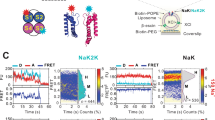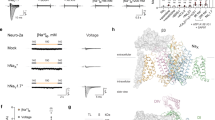Abstract
POTASSIUM channels are highly selective and allow the rapid flux of potassium ions through their pore1. Several studies have implicated the H5 (P or SS1-SS2) segment2,3 as part of the pore in voltage-gated ion channels4–10. The proposal that H5 spans at least 80% of the electric potential drop across the K+ channel pore5,11 is based on altered internal tetraethylammonium sensitivity arising from mutations of H5 residues that are 100% conserved among K+ channels having differing sensitivity to tetraethyl-ammonium5–7,12,13. Here we report that the S6 segment is also involved in K+ ion permeation and in governing the sensitivity to internal tetraethylammonium and barium. Transplanting the S6 segment of NGK2 into Shaker causes this S6 chimaera to adopt the single-channel conductance and sensitivity to internal tetraethylammonium and barium ions from the NGK2 channel. The differences between NGK2 and Shaker in external tetraethylammonium sensitivity, but not single-channel conductance, can be attributed to the differences in their H5 sequences. Three non-conserved S6 residues have been found to affect either single-channel conductance or internal tetraethylammonium sensitivity.
This is a preview of subscription content, access via your institution
Access options
Subscribe to this journal
Receive 51 print issues and online access
$199.00 per year
only $3.90 per issue
Buy this article
- Purchase on Springer Link
- Instant access to full article PDF
Prices may be subject to local taxes which are calculated during checkout
Similar content being viewed by others
References
Hille, B. Ionic Channels of Excitable Membranes (Sinauer, Sunderland, Massachusetts, 1991).
Guy, H. R. & Seetharamulu, P. Proc. natn. Acad. Sci. U.S.A. 83, 508–521 (1986).
Tempel, B. L., Papazian, D. M., Schwarz, T. L., Jan, Y. N. & Jan, L. Y. Science 237, 770–775 (1987).
Yool, A. J. & Schwarz, T. S. Nature 349, 700–704 (1991).
Yellen, G., Jurman, M., Abramson, T. & MacKinnon, R. Science 251, 939–942 (1991).
Hartmann, H. A. et al. Science 251, 942–944 (1991).
Kirsch, G. E. et al. Neuron 8, 499–505 (1992).
Heinemann, S. H., Terlau, H., Stühmer, W., Imoto, K. & Numa, S. Nature 356, 441–443 (1992).
Backx, P. H., Yue, D. T., Lawrence, J. H., Marban, E. & Tomaselli, G. F. Science 257, 248–251 (1992).
Heginbotham, L., Abramson, T. & MacKinnon, R. Science 258, 1152–1155 (1992).
Miller, C. Science 252, 1092–1096 (1991).
Kirsch, G. E., Taglialatela, M. &. & Brown, A. M. Am. J. Physiol. 261, C583–590 (1991).
Taglialatela, M. et al. Molec. Pharmac. 40, 299–307 (1991).
Schwarz, T. S., Tempel, B. L., Papazian, D. M., Jan, Y. N. & Jan, L. Y. Nature 331, 137–142 (1988).
Yokoyama, S. et al. FEBS Lett. 259, 37–42 (1989).
Hoshi, T., Zagotta, W. N. & Aldrich, R. W. Science 250, 533–538 (1990).
Armstrong, C. M. & Binstock, L. J. gen. Physiol. 48, 859–872 (1965).
Armstrong, C. M. J. gen. Physiol. 50, 491–503 (1966).
Armstrong, C. M. J. gen. Physiol. 54, 553–575 (1969).
Armstrong, C. M. J. gen. Physiol. 58, 413–437 (1971).
Armstrong, C. M. & Hille, B. J. gen. Physiol. 59, 388–400 (1972).
Armstrong, C. M. & Taylor, S. R. Biophys. J. 30, 473–488 (1980).
Armstrong, C. M., Swenson, R. P. & Taylor, S. R. J. gen. Physiol. 80, 663–682 (1982).
Hoshi, T., Zagotta, W. N. & Aldrich, R. W. Neuron 7, 547–556 (1991).
Choi, K. L., Mossman, C., Aube, J. & Yellen, G. Neuron 10, 533–541 (1993).
Isacoff, E. Y., Jan, Y. N. & Jan, L. Y. Nature 353, 86–90 (1991).
Slesinger, P. A., Jan, Y. N. & Jan, L. Y. Neuron 11, 739–749 (1993).
Woodhull, A. M. J. gen. Physiol. 61, 687–708 (1973).
Baldwin, T. J., Tsaur, M-L., Lopez, G. A., Jan, Y. N. & Jan, L. Y. Neuron 7, 471–483 (1991).
Lopez, G. A., Jan, Y. N. & Jan, L. Y. Neuron 7, 327–336 (1991).
Author information
Authors and Affiliations
Rights and permissions
About this article
Cite this article
Lopez, G., Nung Jan, Y. & Jan, L. Evidence that the S6 segment of the Shaker voltage-gated K+ channel comprises part of the pore. Nature 367, 179–182 (1994). https://doi.org/10.1038/367179a0
Received:
Accepted:
Issue Date:
DOI: https://doi.org/10.1038/367179a0
This article is cited by
-
The isoforms generated by alternative translation initiation adopt similar conformation in the selectivity filter in TREK-2
Journal of Physiology and Biochemistry (2015)
-
Effects of diltiazem and propafenone on the inactivation and recovery kinetics of fKv1.4 channel currents expressed in Xenopus oocytes
Acta Pharmacologica Sinica (2011)
-
Intracellular gate opening in Shaker K+ channels defined by high-affinity metal bridges
Nature (2004)
Comments
By submitting a comment you agree to abide by our Terms and Community Guidelines. If you find something abusive or that does not comply with our terms or guidelines please flag it as inappropriate.



